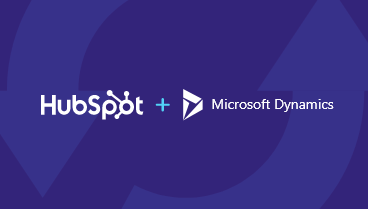
July 9, 2019
You’re probably familiar with HubSpot Marketing Hub and Microsoft Dynamics, a CRM system. You may even be using one, or both at your current company. Having these two platforms as a part of your growth stack can benefit your sales and marketing teams in many ways – from automating tasks, storing contact information, and streamlining your customers’ buyer journey.
But did you know using them separately can still cause a misalignment of your two teams, and negatively affect your sales outcomes? Avoid this misalignment by integrating HubSpot and Dynamics. Combining the two systems to function seamlessly together will result in several benefits for your sales team.
A HubSpot Dynamics integration involves bi-directional syncing of certain data through standard and custom field mapping. For example, a “CRM Account” in Dynamics would map to “Company” in HubSpot and vice versa. This ensures a change in one system automatically syncs to the other, eliminating manual data entry. In fact, with this integration, a contact’s entire HubSpot profile, including form submissions, website behavior, and email activity is available in Dynamics.
For a full look at what objects you can map with the SyncSmart integration, head to the Dynamics product page.
HubSpot’s platform helps you attract and engage with visitors on your site along with other marketing activities. With HubSpot’s platform, you can build trust with leads through campaigns and rank them based on their actions until they’re ready to speak to sales. You can easily set up a process to divide your leads into bottom, middle, and top of the funnel.
You can guide your leads through their customer journey, then set up an alert in your CRM to automatically inform your sales team when they’re ready to discuss your product or services. How? When your prospect accumulates enough points to deem them a SQL, you can set up logic, so the lead is automatically pushed to your CRM and assigned to a specific member of your sales team.
Better lead scoring such as this can help reduce your sales cycle because your sales team is focusing on contacts who are ready to buy.
A HubSpot Dynamics integration lets you personalize the user experience for each contact, thanks to the ability to incorporate user preferences, web history, and interactions into your communications. The information available through an integration includes:
With this data, you can better market to all lifecycle stages and provide them with the right information, at the right time.
While gaining new customers is an important business goal, retaining your current customers is just as important. In fact, it costs five times as much to attract a new customer than to keep an existing one.
Luckily, a HubSpot Dynamics integration can deliver significant ROI around customer retention and happiness. When you sync data like product type, purchase date, renewal date, contract type, and other information, you can build effective customer nurturing campaigns, like:
Establishing and committing to a sales process keeps your team accountable and helps them sell more efficiently. Through a HubSpot Dynamics integration, you can create tasks in your CRM based on contact activity from HubSpot. For instance, you can set up an alert for a member of your sales team to call a prospect when they:
If you ensure your HubSpot Dynamics integration syncs all relevant contextual data around an opportunity or lead, you can also quickly re-engage with contacts who’ve gone cold. With your integration’s data, you can build HubSpot Smart Lists and begin nurturing stalled deals that fit your particular criteria. For example, that may be a list of contacts who haven’t opened any of your emails in the last two month. Then, through your integration, you can launch a retargeting campaign with personalized content.
Closed loop marketing lets you track marketing channels, starting from the moment a visitor lands on your site to the moment your sales department transforms the visitor into a customer. This type of critical analysis is only possible through a HubSpot Dynamics integration.
When you have closed-loop reporting available, you can see which actions you’re taking bring success and which may need adjusting.
Integrating your HubSpot account with Microsoft Dynamics will give you powerful results. However, the integration process can be complex, so it’s best to choose a trusted partner. At SyncSmart, we’ve launched hundreds of successful HubSpot Dynamics integrations, and now offer you the ability to do it yourself with the SyncSmart user interface (UI). Learn more about how you can get started with your integration by visiting our Dynamics product page.